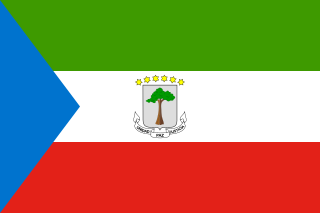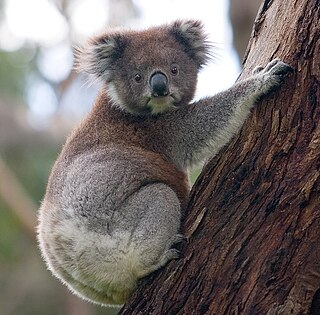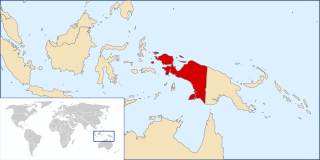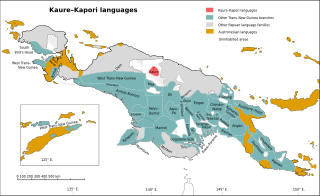
Equatorial Guinea, also rarely known as Equatoguinea, officially the Republic of Equatorial Guinea, is a country on the west coast of Central Africa, with an area of 28,000 square kilometres (11,000 sq mi). Formerly the colony of Spanish Guinea, its post-independence name refers to its location near both the Equator and in the African region of Guinea. As of 2021, the country had a population of 1,468,777, over 85% of whom are ethnically Fang.

Guinea, officially the Republic of Guinea, is a coastal country in West Africa. It borders the Atlantic Ocean to the west, Guinea-Bissau to the northwest, Senegal to the north, Mali to the northeast, Cote d'Ivoire to the southeast, and Sierra Leone and Liberia to the south. It is sometimes referred to as Guinea-Conakry after its capital Conakry, to distinguish it from other territories in the eponymous region such as Guinea-Bissau and Equatorial Guinea. Guinea has a population of 13.5 million and an area of 245,857 square kilometres (94,926 sq mi).

Papua New Guinea, officially the Independent State of Papua New Guinea, is a country in Oceania that comprises the eastern half of the island of New Guinea and its offshore islands in Melanesia. Its capital, located along its southeastern coast, is Port Moresby. The country is the world's third largest island country, with an area of 462,840 km2 (178,700 sq mi).

Port Moresby, also referred to as Pom City or simply Moresby, is the capital and largest city of Papua New Guinea. It is one of the largest cities in the southwestern Pacific outside of Australia and New Zealand. It is located on the shores of the Gulf of Papua, on the south-western coast of the Papuan Peninsula of the island of New Guinea. The city emerged as a trade centre in the second half of the 19th century. During World War II, it was a prime objective for conquest by the Imperial Japanese forces during 1942–43 as a staging point and air base to cut off Australia from Southeast Asia and the Americas.

The guinea pig or domestic guinea pig, also known as the cavy or domestic cavy, is a species of rodent belonging to the genus Cavia in the family Caviidae. Breeders tend to use the word cavy to describe the animal, while in scientific and laboratory contexts, it is far more commonly referred to by the common name guinea pig. Despite their common name, guinea pigs are not native to Guinea, nor are they closely related biologically to pigs, and the origin of the name is still unclear. They originated in the Andes of South America. Studies based on biochemistry and hybridization suggest they are domesticated animals that do not exist naturally in the wild, descendants of a closely related cavy species such as C. tschudii. They were originally domesticated as livestock for a source of meat, and are still consumed in some parts of the world.

Melanesia is a subregion of Oceania in the southwestern Pacific Ocean. It extends from New Guinea in the west to the Fiji Islands in the east, and includes the Arafura Sea.

The guinea was a coin, minted in Great Britain between 1663 and 1814, that contained approximately one-quarter of an ounce of gold. The name came from the Guinea region in West Africa, from where much of the gold used to make the coins was sourced. It was the first English machine-struck gold coin, originally representing a value of 20 shillings in sterling specie, equal to one pound, but rises in the price of gold relative to silver caused the value of the guinea to increase, at times to as high as thirty shillings. From 1717 to 1816, its value was officially fixed at twenty-one shillings.

The prime minister of the Independent State of Papua New Guinea is Papua New Guinea's head of government, consequent on being the leader of the party or coalition with majority support in the National Parliament. The prime minister serves as the head of his party, the head of the coalition government, and the chairman of the National Executive Council.

The Vombatiformes are one of the three suborders of the large marsupial order Diprotodontia. Seven of the nine known families within this suborder are extinct; only the families Phascolarctidae, with the koala, and Vombatidae, with three extant species of wombat, survive.

The Papuan languages are the non-Austronesian and non-Australian languages spoken on the western Pacific island of New Guinea, as well as neighbouring islands in Indonesia, Papua New Guinea, Solomon Islands, and East Timor by around 4 million people. It is a strictly geographical grouping, and does not imply a genetic relationship.
This gallery of sovereign state flags shows the national or state flags of sovereign states that appear on the list of sovereign states. For other flags, please see flags of active autonomist and secessionist movements, flags of extinct states and gallery of flags of dependent territories. Each flag is depicted as if the flagpole is positioned on the left of the flag, except for those of the Islamic Emirate of Afghanistan, Iran, Iraq, and Saudi Arabia, which are depicted with the hoist to the right.

Western New Guinea, also known as Papua, Indonesian New Guinea, Indonesian Papua, West Papua New Guinea, is the western, Indonesian half of the island of New Guinea. Since the island is alternatively named as Papua, the region is also called West Papua.

The Papua New Guinea national cricket team, nicknamed the Barramundis, is the team that represents the country of Papua New Guinea in international cricket. The team is organised by Cricket PNG, which has been an Associate Member of the International Cricket Council (ICC) since 1973. Papua New Guinea previously had One-Day International (ODI) status, which it gained by finishing fourth in 2014 World Cup Qualifier. Papua New Guinea lost both their ODI and T20I status in March 2018 after losing a playoff match against Nepal during the 2018 Cricket World Cup Qualifier, a result that earned ODI and T20I status for their opponents. On 26 April 2019, PNG defeated Oman to finish to scure a top-four finish in the 2019 ICC World Cricket League Division Two and reclaim their ODI status.

Papua New Guinea, a sovereign state in Oceania, is the most linguistically diverse country in the world. According to Ethnologue, there are 840 living languages spoken in the country. In 2006, Papua New Guinea Prime Minister Sir Michael Somare stated that "Papua New Guinea has 832 living languages ." Languages with statutory recognition are Tok Pisin, English, Hiri Motu, and Papua New Guinean Sign Language. Tok Pisin, an English-based creole, is the most widely spoken, serving as the country's lingua franca. Papua New Guinean Sign Language became the fourth officially recognised language in May 2015, and is used by the deaf population throughout the country.

The Kayagar languages are a small family of four closely related Trans–New Guinea languages spoken around the Cook River of Indonesian New Guinea:

The Kaure–Kosare or Nawa River languages are a small family spoken along the Nawa River in West Papua, near the northern border with Papua New Guinea. The languages are Kaure and Kosare.
The Paniai Lakes languages, also known as the Wissel Lakes or Wissel Lakes – Kemandoga River, are a small family of closely related Trans–New Guinea languages spoken in the Paniai Lakes region of the highlands of Western New Guinea in the Paniai Lakes region of Papua. Foley (2003) considers their Trans–New Guinea status to be established.

The continent of Australia, sometimes known in technical contexts by the names Sahul, Australia-New Guinea, Australinea, Meganesia, or Papualand to distinguish it from the country of Australia, is located within the Southern and Eastern hemispheres. The name "Sahul" takes its name from the Sahul Shelf, which is a part of the continental shelf of the Australian continent. The continent includes mainland Australia, Tasmania, the island of New Guinea, the Aru Islands, the Ashmore and Cartier Islands, most of the Coral Sea Islands, and some other nearby islands. Situated in the geographical region of Oceania, Australia is the smallest of the seven traditional continents.

New Guinea is the world's second-largest island, with an area of 785,753 km2 (303,381 sq mi). Located in Oceania in the southwestern Pacific Ocean, the island is separated from Australia by the 150-kilometre wide Torres Strait, though both landmasses lie on the same continental shelf. Numerous smaller islands are located to the west and east.

India and Papua New Guinea established diplomatic relations in 1975. Papua New Guinea has a High Commission in New Delhi, whilst India operates a High Commission in Port Moresby.



















